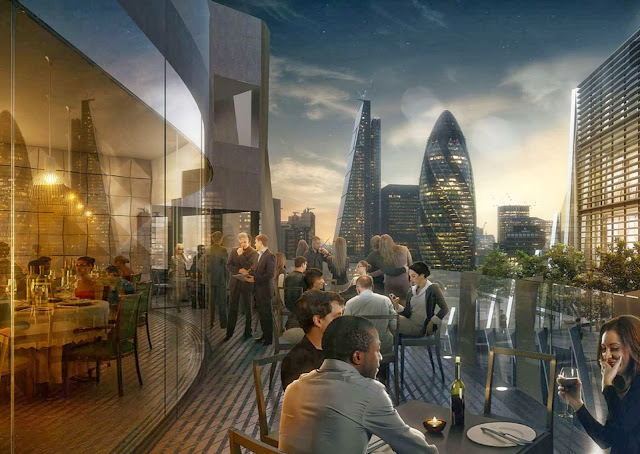ACME, on behalf of 4C Hotel Group, has submitted planning application for the Minories Redevelopment in the City of London.
The development includes a 20,000 sqm office building, a 16,500 sqm Hampton by Hilton Hotel with 370 rooms, and an 8,000 sqm residential building. The scheme has at its heart a new landscaped park and a number of smaller urban squares.
The redevelopment of the site is an important step in the regeneration and expansion of the core fabric of the City of London eastwards beyond the confines of Aldgate, helping to re-structure an area with a very inconsistent physical and social fabric. A masterplan for the core site was subsequently developed, utilising some of the existing buildings and leaving the adjoining bus station unaffected.
Within its site boundary the Minories development is a microcosm of this evolving environment. The site’s strategic location, on Aldgate High Street positions the new office building at a central urban location, and provides the opportunity for the building to play a role in the life and image of the city. The building’s massing was developed to maximise its size while respecting constraints such as the Tower of London view corridor and distance to the site boundary.
The building is one large volume, made permeable at ground floor level by the arcade on the long western and southern façades and by the set back at historic Harrow Alley on the East allowing for better pedestrian flow. The building volume is further broken up by two large scale terraces and by the textured façade which helps to dissolve the large elevation surfaces. The main access to the building is through a generous double height entrance lobby on Aldgate High Street.
The building is partially located above underground lines, which limit the areas for possible foundations to an absolute minimum. The façade consists of a curtain wall and two layers of fins that help unify and animate the large surfaces of the façade. The fins give a resonant and dynamic appearance to the office massing and also perform as a shading device. The depth of the fins varies depending on the orientation in order to enhance their performance.
The current structural façade raises concerns as it lacks insulation and windows can only be replaced internally. The fins are structural and must be retained in place. It is proposed to replace all glazing and spandrel panels, and to overclad the structural concrete fins with metal fins that retain the verticality of the building and add subtle variation and play to the current regimented fins.
Residential options were tested for viability, daylight impact and visibility to create a development of sufficient size to support the creation of a significant new green park for managed public use. Instead of opting for large vertical surfaces, the building expresses it’s residential scale with smaller volumes that reflect the spatial layout of the flats.
This fragmented geometry contributes to the buildings appearance as smaller than it’s volume would suggest, and allows it to subtly shift forwards and backwards to optimise daylight. In order to address privacy issues created by the expansive use of glass, external metal mesh curtains have been integrated in the façade to give each user an individual and integrated element to control exposure and transparency for each room.
The ambition of the scheme is to provide an architectural proposal that resolves the specific complexities and contradictions of this key site. The highly fragmented yet largely inaccessible site will be made more permeable by creating a series of public spaces.
Location: London, UK
Architects: ACME
Project Team: Rodrigo Canizares, Monica Capitanio, Anna Czigler, Ann-Kathrin Koehl, Duarte Lobo Antunes, Friedrich Ludewig, Iria de la Peña, David Rieser
Size: 20,000 sqm offices, 16,500 sqm hotel, 8,000 sqm residential
Date: 2013-2016
Client: 4CHotel Group













